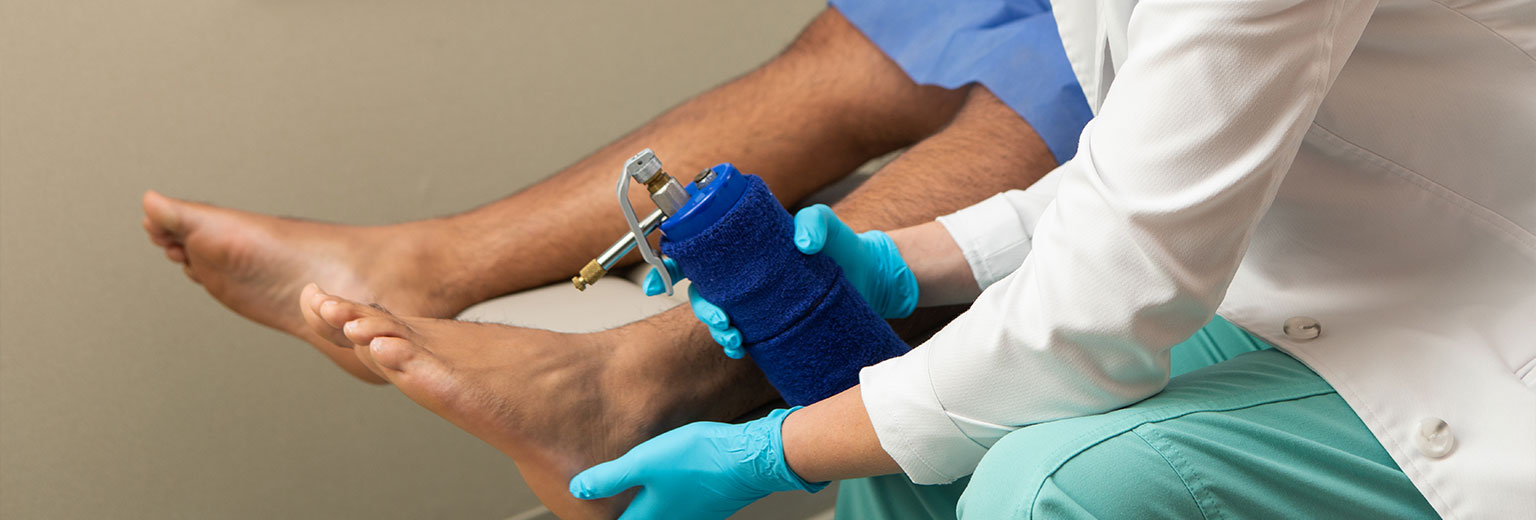Cryotherapy is a specialized treatment that uses extreme cold to freeze and destroy abnormal tissue. This treatment is frequently used by dermatologists to treat actinic keratoses (AKs), benign skin growths, and viral warts. Also called cryoablation or cryosurgery, cryotherapy is a safe and effective treatment for abnormal skin tissue and can restore smooth, even, healthy skin.
Uses for Cryotherapy
Cryotherapy is used to treat the following:
- Actinic keratoses (AKs): AKs are precancerous skin lesions, which means they could develop into skin cancer at any point. For this reason, AKs are taken seriously and should be treated immediately to prevent you from developing skin cancer. Cryotherapy for AKs eliminates the abnormal tissue and reduces your risk of skin cancer.
- Benign skin growths: Benign skin growths such as skin tags are mostly harmless. However, they can cause physical discomfort and may be considered unsightly. Your dermatologist can remove benign skin growths with cryotherapy.
- Viral warts: Viral warts are thick, firm skin growths caused by the HPV virus. Although they will not harm you and will eventually go away on their own, they are contagious and may last for years. Getting cryotherapy treatment for warts can minimize HPV spread and eliminates warts far more quickly than letting them go away on their own.

Advantages of Cryotherapy
Cryotherapy has several advantages over alternative treatments. It is highly effective in removing abnormal skin tissue. As a minimally invasive treatment, it does not require surgery. It has no associated bleeding and it has a low risk of damaging healthy surrounding tissue. Cryotherapy causes little pain, and most people recovery quickly from the procedure. Overall, this skin treatment is relatively inexpensive and is considered safe and reliable.
Cryotherapy Treatment
Cryotherapy is performed using an extremely cold substance called liquid nitrogen. A spraying device or cotton swab is used to apply the liquid nitrogen to the skin. The skin cells cannot survive the extreme cold and freeze. Once frozen, the tissue will fall off the skin on its own within two to four weeks. Occasionally, a second cryotherapy treatment will need to be performed to fully remove the abnormal tissue.
Most people do not need to do anything special to prepare for cryotherapy on the skin, nor will special care be needed afterward. After the treatment, the skin will turn red and may form a blister. Any pain will be minimal and will be gone within a few days. The treated area will ultimately develop a scab that will heal within a few weeks.
Risks and Complications
As with most medical procedures, there are some risks with cryotherapy. Patients usually experience some temporary redness, swelling or discomfort. If cryotherapy was administered near the eye, the eyelid may become puffy for a few days. The treated area of skin will often blister within a few hours. Depending on the individual, the skin may develop a scar. If you experience signs of an infection (uncommon) or loss of feeling (usually temporary) in the treated area, contact your dermatologist. Patients should note that some skin conditions treated with cryotherapy (such as AKs) may return, necessitating additional cryotherapy sessions.
Results of Cryotherapy
Cryotherapy completely destroys the abnormal skin tissue. After the tissue has fallen off, the skin may appear completely normal without any sign of the former skin lesion.

